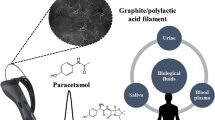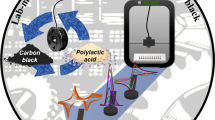Abstract
A novel conductive filament based on graphite (Gr) dispersed in polylactic acid polymer matrix (PLA) is described to produce 3D-electrochemical devices (Gr/PLA). This conductive filament was used to additively manufacture electrochemical sensors using the 3D pen. Thermogravimetric analysis confirmed that Gr was successfully incorporated into PLA, achieving a composite material (40:60% w/w, Gr and PLA, respectively), while Raman and scanning electron microscopy revealed the presence of defects and a high porosity on the electrode surface, which contributes to improved electrochemical performance. The 3D-printed Gr/PLA electrode provided a more favorable charge transfer (335 Ω) than the conventional glassy carbon (1277 Ω) and 3D-printed Proto-pasta® (3750 Ω) electrodes. As a proof of concept, the ciprofloxacin antibiotic, a species of multiple interest, was selected as a model molecule. Thus, a square wave voltammetry (SWV) method was proposed in the potential range + 0.9 to + 1.3 V (vs Ag|AgCl|KCl(sat)), which provided a wide linear working range (2 to 32 µmol L−1), 1.79 µmol L−1 limit of detection (LOD), suitable precision (RSD < 7.9%), and recovery values from 94 to 109% when applied to pharmaceutical and milk samples. Additionally, the sensor is free from the interference of other antibiotics routinely employed in veterinary practices. This device is disposable, cost-effective, feasibly produced in financially limited laboratories, and consequently promising for evaluation of other antibiotic species in routine applications.
Graphical Abstract






Similar content being viewed by others
Data Availability
The authors of the paper entitled “Cost-effective protocol to produce 3D-printed electrochemical devices using a 3D pen and lab-made filaments for ciprofloxacin sensing” declare that they are available to provide any information and data about this work upon request.
References
Neumaier JM, Madani A, Klein T, Ziegler T (2019) Low-budget 3D-printed equipment for continuous flow reactions. Beilstein J Org Chem 15:558–566. https://doi.org/10.3762/bjoc.15.50
Flowers PF, Reyes C, Ye S et al (2017) 3D printing electronic components and circuits with conductive thermoplastic filament. Addit Manuf 18:156–163. https://doi.org/10.1016/j.addma.2017.10.002
Tully JJ, Meloni GN (2020) A scientist’s guide to buying a 3D printer: how to choose the right printer for your laboratory. Anal Chem 92:14853–14860. https://doi.org/10.1021/acs.analchem.0c03299
BG PK, Mehrotra S, Marques SM, et al (2023) 3D printing in personalized medicines: a focus on applications of the technology. Mater Today Commun 105875.https://doi.org/10.1016/j.mtcomm.2023.105875
Shen D, Zhang M, Mujumdar AS, Li J (2023) Advances and application of efficient physical fields in extrusion based 3D food printing technology. Trends Food Sci Technol 131:104–117. https://doi.org/10.1016/j.tifs.2022.11.017
Vasamsetty P, Pss T, Kukkala D et al (2020) 3D printing in dentistry – exploring the new horizons. Mater Today Proc 26:838–841. https://doi.org/10.1016/j.matpr.2020.01.049
Prasad KV, Vasugi V, Senthil Kumaran G (2023) Application of 3D printing concepts in the architecture engineering and construction (AEC) industry - a scientometric review. Mater Today Proc. https://doi.org/10.1016/j.matpr.2023.02.158
Hamzah HH, Shafiee SA, Abdalla A, Patel BA (2018) 3D printable conductive materials for the fabrication of electrochemical sensors: a mini review. Electrochem commun 96:27–31. https://doi.org/10.1016/j.elecom.2018.09.006
Veloso WB, Paixão TRLC, Meloni GN (2023) 3D printed electrodes design and voltammetric response. Electrochim Acta 449:142166. https://doi.org/10.1016/j.electacta.2023.142166
Gross B, Lockwood SY, Spence DM (2017) Recent advances in analytical chemistry by 3D printing. Anal Chem 89:57–70. https://doi.org/10.1021/acs.analchem.6b04344
Abdalla A, Patel BA (2020) 3D-printed electrochemical sensors: a new horizon for measurement of biomolecules. Curr Opin Electrochem 20:78–81. https://doi.org/10.1016/j.coelec.2020.04.009
Stefano JS, Kalinke C, da Rocha RG et al (2022) Electrochemical (bio)sensors enabled by fused deposition modeling-based 3D printing: a guide to selecting designs, printing parameters, and post-treatment protocols. Anal Chem 94:6417–6429. https://doi.org/10.1021/acs.analchem.1c05523
Cardoso RM, Rocha DP, Rocha RG et al (2020) 3D-printing pen versus desktop 3D-printers: fabrication of carbon black/polylactic acid electrodes for single-drop detection of 2,4,6-trinitrotoluene. Anal Chim Acta 1132:10–19. https://doi.org/10.1016/j.aca.2020.07.034
O’Neil GD, Ahmed S, Halloran K et al (2019) Single-step fabrication of electrochemical flow cells utilizing multi-material 3D printing. Electrochem Commun 99:56–60. https://doi.org/10.1016/j.elecom.2018.12.006
Vaněčková E, Bouša M, NovákováLachmanová Š et al (2020) 3D printed polylactic acid/carbon black electrodes with nearly ideal electrochemical behaviour. J Electroanal Chem 857:113745. https://doi.org/10.1016/j.jelechem.2019.113745
Kalinke C, de Oliveira PR, Neumsteir NV et al (2022) Influence of filament aging and conductive additive in 3D printed sensors. Anal Chim Acta 1191:339228. https://doi.org/10.1016/j.aca.2021.339228
Cardoso RM, Mendonça DMH, Silva WP et al (2018) 3D printing for electroanalysis: From multiuse electrochemical cells to sensors. Anal Chim Acta 1033:49–57. https://doi.org/10.1016/j.aca.2018.06.021
Browne MP, Novotný F, Sofer Z, Pumera M (2018) 3D printed graphene electrodes’ electrochemical activation. ACS Appl Mater Interfaces 10:40294–40301. https://doi.org/10.1021/acsami.8b14701
Cardoso RM, Castro SVF, Silva MNT et al (2019) 3D-printed flexible device combining sampling and detection of explosives. Sensors Actuators, B Chem 292:308–313. https://doi.org/10.1016/j.snb.2019.04.126
Richter EM, Rocha DP, Cardoso RM et al (2019) Complete additively manufactured (3D-printed) electrochemical sensing platform. Anal Chem 91:12844–12851. https://doi.org/10.1021/acs.analchem.9b02573
Novotný F, Urbanová V, Plutnar J, Pumera M (2019) Preserving fine structure details and dramatically enhancing electron transfer rates in graphene 3D-printed electrodes via thermal annealing: toward nitroaromatic explosives sensing. ACS Appl Mater Interfaces 11:35371–35375. https://doi.org/10.1021/acsami.9b06683
Gusmão R, Browne MP, Sofer Z, Pumera M (2019) The capacitance and electron transfer of 3D-printed graphene electrodes are dramatically influenced by the type of solvent used for pre-treatment. Electrochem Commun 102:83–88. https://doi.org/10.1016/j.elecom.2019.04.004
Koterwa A, Kaczmarzyk I, Mania S et al (2022) The role of electrolysis and enzymatic hydrolysis treatment in the enhancement of the electrochemical properties of 3D-printed carbon black/poly(lactic acid) structures. Appl Surf Sci 574:151587. https://doi.org/10.1016/j.apsusc.2021.151587
Wirth DM, Sheaff MJ, Waldman JV et al (2019) Electrolysis activation of fused-filament-fabrication 3D-printed electrodes for electrochemical and spectroelectrochemical analysis. Anal Chem 91:5553–5557. https://doi.org/10.1021/acs.analchem.9b01331
Cruz MA, Ye S, Kim MJ et al (2018) Multigram synthesis of Cu-Ag core–shell nanowires enables the production of a highly conductive polymer filament for 3D printing electronics. Part Part Syst Charact 35:1700385. https://doi.org/10.1002/ppsc.201700385
Foster CW, Elbardisy HM, Down MP et al (2020) Additively manufactured graphitic electrochemical sensing platforms. Chem Eng J 381:122343. https://doi.org/10.1016/j.cej.2019.122343
Stefano JS, Guterres e Silva LR, Rocha RG et al (2022) New conductive filament ready-to-use for 3D-printing electrochemical (bio)sensors: towards the detection of SARS-CoV-2. Anal Chim Acta 1191:339372. https://doi.org/10.1016/j.aca.2021.339372
Stefano JS, e Silva LRG, Janegitz BC (2022) New carbon black-based conductive filaments for the additive manufacture of improved electrochemical sensors by fused deposition modeling. Microchim Acta 189:414. https://doi.org/10.1007/s00604-022-05511-2
Lopes CEC, de Faria LV, Araújo DAG et al (2023) Lab-made 3D-printed electrochemical sensors for tetracycline determination. Talanta 259:124536. https://doi.org/10.1016/j.talanta.2023.124536
Guterres Silva LR, Santos Stefano J, Cornélio Ferreira Nocelli R, Campos Janegitz B (2023) 3D electrochemical device obtained by additive manufacturing for sequential determination of paraquat and carbendazim in food samples. Food Chem 406:135038. https://doi.org/10.1016/j.foodchem.2022.135038
Silva LRG, Stefano JS, Crapnell RD et al (2023) Additive manufactured microfluidic device for electrochemical detection of carbendazim in honey samples. Talanta Open 7:100213. https://doi.org/10.1016/j.talo.2023.100213
de Faria LV, Lisboa TP, da Campos NS et al (2021) Electrochemical methods for the determination of antibiotic residues in milk: a critical review. Anal Chim Acta 1173:338569. https://doi.org/10.1016/j.aca.2021.338569
Joshi A, Kim K-H (2020) Recent advances in nanomaterial-based electrochemical detection of antibiotics: challenges and future perspectives. Biosens Bioelectron 153:112046. https://doi.org/10.1016/j.bios.2020.112046
Rudnicki K, Sipa K, Brycht M et al (2020) Electrochemical sensing of fluoroquinolone antibiotics. TrAC Trends Anal Chem 128:115907. https://doi.org/10.1016/j.trac.2020.115907
Cazedey E, Salgado H (2012) Spectrophotometric determination of ciprofloxacin hydrochloride in ophthalmic solution. Currículo Lattes 2:74–79. https://doi.org/10.5923/j.aac.20120206.01
Mofokeng JP, Luyt AS, Tábi T, Kovács J (2012) Comparison of injection moulded, natural fibre-reinforced composites with PP and PLA as matrices. J Thermoplast Compos Mater 25:927–948. https://doi.org/10.1177/0892705711423291
Hansen G, Næss E, Kristjansson K (2015) Sintered nickel powder wicks for flat vertical heat pipes. Energies 8:2337–2357. https://doi.org/10.3390/en8042337
Pimenta MA, Dresselhaus G, Dresselhaus MS et al (2007) Studying disorder in graphite-based systems by Raman spectroscopy. Phys Chem Chem Phys 9:1276–1290. https://doi.org/10.1039/B613962K
Reich S, Thomsen C (2004) Raman spectroscopy of graphite. Philos. Trans. R. Soc A Math Phys Eng Sci 362:2271–2288
Bokobza L, Bruneel J-L, Couzi M (2015) Raman spectra of carbon-based materials (from graphite to carbon black) and of some silicone composites. C 1:77–94. https://doi.org/10.3390/c1010077
Weng Y-X, Jin Y-J, Meng Q-Y et al (2013) Biodegradation behavior of poly(butylene adipate-co-terephthalate) (PBAT), poly(lactic acid) (PLA), and their blend under soil conditions. Polym Test 32:918–926. https://doi.org/10.1016/j.polymertesting.2013.05.001
dos Santos PL, Katic V, Loureiro HC et al (2019) Enhanced performance of 3D printed graphene electrodes after electrochemical pre-treatment: role of exposed graphene sheets. Sensors Actuators B Chem 281:837–848. https://doi.org/10.1016/j.snb.2018.11.013
Ţucureanu V, Matei A, Avram AM (2016) FTIR spectroscopy for carbon family study. Crit Rev Anal Chem 46:502–520. https://doi.org/10.1080/10408347.2016.1157013
Franco Guzmán M, Álvarez-Romero GA, Mendoza Huizar LH et al (2018) Influence on the electroactive area of the electrode’s nature and the transformed redox molecule. ECS Trans 84:235–242. https://doi.org/10.1149/08401.0235ecst
Lisboa TP, Alves GF, de Faria LV et al (2022) 3D-printed electrode an affordable sensor for sulfanilamide monitoring in breast milk, synthetic urine, and pharmaceutical formulation samples. Talanta 247:123610. https://doi.org/10.1016/j.talanta.2022.123610
Martin Santos A, Wong A, Araújo Almeida A, Fatibello-Filho O (2017) Simultaneous determination of paracetamol and ciprofloxacin in biological fluid samples using a glassy carbon electrode modified with graphene oxide and nickel oxide nanoparticles. Talanta 174:610–618. https://doi.org/10.1016/j.talanta.2017.06.040
de Faria LV, Lisboa TP, Alves GF et al (2020) Electrochemical study of different sensors for simple and fast quantification of ciprofloxacin in pharmaceutical formulations and bovine milk. Electroanalysis 32:2266–2272. https://doi.org/10.1002/elan.202060211
Rahimpour R, Sabeti B, Chekin F (2021) Electrochemical sensor based on nitrogen doped porous reduced graphene oxide to detection of ciprofloxacin in pharmaceutical samples. Russ J Electrochem 57:654–662. https://doi.org/10.1134/S1023193520120186
Rkik M, Ben BM, Samet Y (2017) Electrochemical determination of levofloxacin antibiotic in biological samples using boron doped diamond electrode. J Electroanal Chem 794:175–181. https://doi.org/10.1016/j.jelechem.2017.04.015
de Souza CC, Alves GF, Lisboa TP et al (2022) Low-cost paper-based electrochemical sensor for the detection of ciprofloxacin in honey and milk samples. J Food Compos Anal 112:104700. https://doi.org/10.1016/j.jfca.2022.104700
Tajeu KY, Ebunang DVT, Tonleu RCT et al (2021) Electroanalytical application of thiol-grafted laponite to the sensitive quantification of ciprofloxacin antibiotic. J Appl Electrochem 51:435–446. https://doi.org/10.1007/s10800-020-01508-y
Pollap A, Baran K, Kuszewska N, Kochana J (2020) Electrochemical sensing of ciprofloxacin and paracetamol in environmental water using titanium sol based sensor. J Electroanal Chem 878:114574. https://doi.org/10.1016/j.jelechem.2020.114574
Hernández P, Aguilar-Lira GY, Islas G, Rodriguez JA (2021) Development of a new voltammetric methodology for the determination of ciprofloxacin in beef samples using a carbon paste electrode modified with nafion and fullerenes. Electroanalysis 33:1539–1546. https://doi.org/10.1002/elan.202060525
Garbellini GS, Rocha-Filho RC, Fatibello-Filho O (2015) Voltammetric determination of ciprofloxacin in urine samples and its interaction with dsDNA on a cathodically pretreated boron-doped diamond electrode. Anal Methods 7:3411–3418. https://doi.org/10.1039/C5AY00625B
Acknowledgements
This research was supported by CNPq (National Council for Scientific and Technological Development, process: 303815/2022-1 and 150604/2022-0), CAPES (Coordination for the Improvement of Higher Education Personnel, financial code 001), FAPERJ ((E-26/211.465/2019, E-33/201.429/2022, E-26/205.806/2022, and 205.807/2022), and PROPESQ/UFJF.
Author information
Authors and Affiliations
Corresponding authors
Ethics declarations
Competing interests
The authors declare no competing interests.
Additional information
Publisher's note
Springer Nature remains neutral with regard to jurisdictional claims in published maps and institutional affiliations.
Supplementary Information
Below is the link to the electronic supplementary material.
Rights and permissions
Springer Nature or its licensor (e.g. a society or other partner) holds exclusive rights to this article under a publishing agreement with the author(s) or other rightsholder(s); author self-archiving of the accepted manuscript version of this article is solely governed by the terms of such publishing agreement and applicable law.
About this article
Cite this article
Lisboa, T.P., de Faria, L.V., de Oliveira, W.B.V. et al. Cost-effective protocol to produce 3D-printed electrochemical devices using a 3D pen and lab-made filaments to ciprofloxacin sensing. Microchim Acta 190, 310 (2023). https://doi.org/10.1007/s00604-023-05892-y
Received:
Accepted:
Published:
DOI: https://doi.org/10.1007/s00604-023-05892-y




